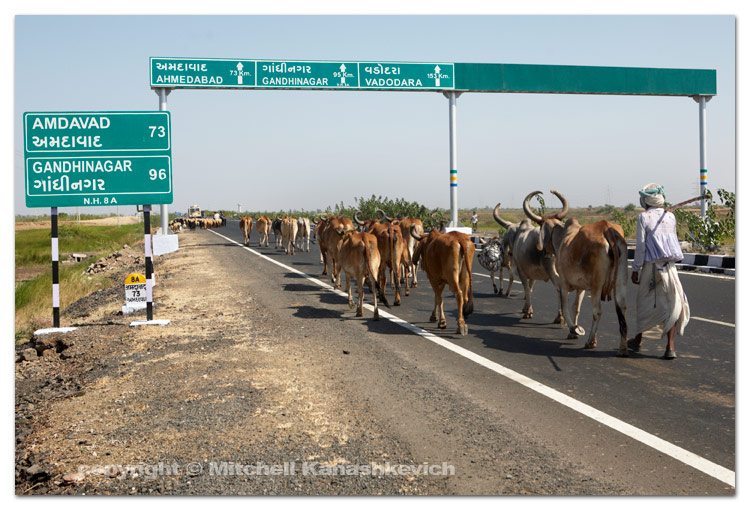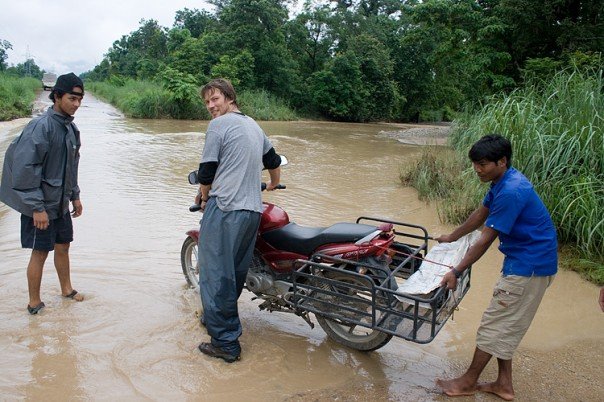Riding a motorcycle in India
 The ride to Ahmedabad was a reminder why I love this life on the road. Just me and my wife Tanya, riding through what are often beautiful, unfamiliar lands, experiencing everything together – this has been a large part of our lives over the last three years. In many ways it is as romantic as some may think, but there is another side, one which is not so nice.The beauty you see is sometimes matched by the horror (to me at least) - the amount of killed dogs on the roads is impossible to count, the scenery is not always ideal - ugly buildings and industrial, smoke belching areas really do not make for inspirational riding. And then there are the road users, who, well let’s just say they do not always act as one might expect, nor do the pedestrians – I’ve had much more close calls than I would have liked to, over the years. To top everything off there is the ‘pain in the butt factor’ (literally) – over a long journey a motorcycle seat becomes the least comfortable place in the world and even a roach-infested hotel starts to seem like a welcoming alternative. Riding around India is not easy, but it is far from impossible and not as insane as many visitors to India may think. All that one needs is the knowledge of how the Indian roads work, once things begin to make sense everything starts to feel much less daunting.
The ride to Ahmedabad was a reminder why I love this life on the road. Just me and my wife Tanya, riding through what are often beautiful, unfamiliar lands, experiencing everything together – this has been a large part of our lives over the last three years. In many ways it is as romantic as some may think, but there is another side, one which is not so nice.The beauty you see is sometimes matched by the horror (to me at least) - the amount of killed dogs on the roads is impossible to count, the scenery is not always ideal - ugly buildings and industrial, smoke belching areas really do not make for inspirational riding. And then there are the road users, who, well let’s just say they do not always act as one might expect, nor do the pedestrians – I’ve had much more close calls than I would have liked to, over the years. To top everything off there is the ‘pain in the butt factor’ (literally) – over a long journey a motorcycle seat becomes the least comfortable place in the world and even a roach-infested hotel starts to seem like a welcoming alternative. Riding around India is not easy, but it is far from impossible and not as insane as many visitors to India may think. All that one needs is the knowledge of how the Indian roads work, once things begin to make sense everything starts to feel much less daunting.
Here are some simple tips for those who want to ride a motorcycle around India or simply want to know what it’s like.
Buy a motorcycle that will not keep breaking down Buying a 20-year-old Enfield that has been ridden by every foreigner in Goa that ever wanted to ride a bike is not a good idea. I have used a Bajaj Pulsar and a Hero Honda CBZ. I prefer the first and this is the bike that I still have. Both are 150cc bikes, but they will get you through almost any tough roads. The Pulsar gives a better mileage per liter and from personal experience I can say that I have pushed it to the max and beyond and it survived. These bikes can be bought second hand; I wouldn’t go for anything that is more than 5 years old. To give an idea of a price - my 2003 Pulsar cost 33,000 Rupees in 2007. It was in great condition and didn’t have any breakdowns throughout the journey. Those who have more cash to fork out or prefer a bigger bike – go for one of the newer Enfields, from every single account I have heard that the old ones break down very often, but a wise young Indian man told me that his new Enfield hasn’t had so much as a flat tire, that sounds good to me.
Size Matters On Indian roads whoever is bigger has the right of way. Do not try to play chicken with a truck; you may not like the results. The only exception to the rule is the cow; it roams the streets freely, at a leisurely pace, while everyone stops and gives way.
Volume Matters – The horn is your friend Everyone on Indian roads uses the horn with no remorse. The louder your horn the more chances you have of being heard by the half-asleep truck driver who is listening to very loud music and blocking your lane to overtake him. The horn should be used in many situations. When you see a grandmother crossing the road with a pile of wood on her head without looking to either side – use the horn. When you approach a herd of cows or goats – use the horn; they will often part for you. When you want to overtake a vehicle – use the horn. When you go through a forested area, which potentially houses animals you should scare the crap out of them, so they do not come near the road – use the horn Basically any time you are in doubt – use the horn.
Expect the unexpected Just because a one-way, two-lane road means one-way in your country doesn’t mean it is the same in India. You will see vehicles in the wrong lane all the time, but I was surprised the first time I saw a truck doing 80 km/h in the opposite direction of a one-way national highway. Indian road users seem to be very practical and rules are only obeyed if they serve a practical purpose. Petrol is relatively expensive in India and going 5km till the next U-Turn to get into the correct lane is seen as not practical. Other unexpected occurrences include animals and children running onto the middle of the road and then there are the tree thorns. Apparently the Indian government made the initiative to plant a certain type of tree along the roads, so as to make India greener and less polluted. It just so happens that the tree grows huge thorns and in the dry season, when some of the branches fall off, they inevitably end up on the roads. The thorns will puncture your tires; ask me, I spent a month recovering from an accident after puncturing the front tire of my bike and loosing control.
Flash your headlights When a vehicle is speeding towards you at an insane speed in your lane and you have no place to give way, the signal to communicate your predicament is to flash your headlights. The more you flash them the more urgency you communicate. For the ultimate effect flash the lights and sound the horn.
Learn to read the road This is kinda obvious, as we must learn to look for clues that could signal a potential hazard on the roads at home. However there are additional hazards in India as well as additional signals. For example - a turbaned man carrying a long stick over his shoulder is a shepherd and if you are seeing him, there is a good chance that his herd of cattle is soon to follow.
I’ve got your back The reason why you may often see vehicles turning or doing maneuvers in the middle of the road without ever checking the mirrors or looking behind is because the vehicle coming from behind is expected to be aware that the one at the front can do anything at any time. This rule mostly applies to city/town roads with heavy traffic, however doing it like the locals is not really recommended, just be aware of things are.
Riding after dark is not a good idea First there are the huge bugs that smash against the helmet screen, or take out your eyes if you don’t have protection. There are also the wonderful drivers/riders who only use high beam on roads outside well-lit areas. If you are heading in the opposite direction of a vehicle that is using the high beam you pretty much cannot see anything except for the light, considering that a cow could a few meters in front, this is not a very good situation to be in. Then there are those vehicles which are huge, but look like small vehicles because they only have one light working. A big truck can easily look like a motorcycle when one of its headlights is broken, but mistaking it for a motorcycle can lead to a very unhappy ending.

Well, that’s about it. I’ve probably missed a lot, but then a whole book can probably be written on the topic of motorcycle riding around India.